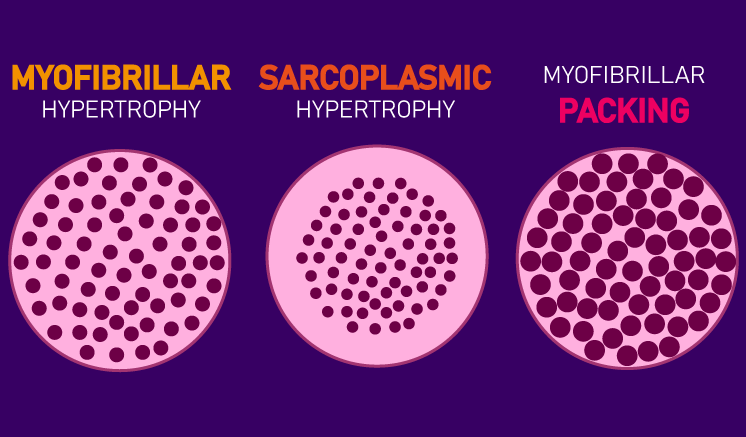
When it comes to muscles increasing in size, an increase in muscle fiber cross-sectional area appears to be one of the primary ways this occurs.
Specifically, there appear to be 3 underlying ways a muscle fiber can increase in cross-sectional area: myofibrillar hypertrophy, sarcoplasmic hypertrophy, and myofibrillar packing.
In this article, we aim to find out which, in any, of these 3 ways of muscle fiber growth are most likely behind an increase in whole muscle size with typical resistance training.
Moreover, we’ll also try to assess if there’s a particular way you can train for either 3 of these underlying ways.
Firstly, to make sure we’re all on the same page, it is useful to define myofibrillar hypertrophy, sarcoplasmic hypertrophy, and myofibrillar packing.
To do so, we first need to understand the structure of a muscle.
Table of Contents
- Structure of a Muscle
- Defining Myofibrillar Hypertrophy, Sarcoplasmic Hypertrophy, and Myofibrillar Packing
- How Researchers Assess Changes at the Fiber Level
- The Research: Myofibrillar Hypertrophy vs Sarcoplasmic Hypertrophy vs Myofibrillar Packing
- Can You Train For Myofibrillar Hypertrophy, Sarcoplasmic Hypertrophy, or Myofibrillar Packing?
- Takeaway Points
Structure of a Muscle
Muscles are organized in hierarchical layers.
Within the whole muscle are fascicles, within fascicles are muscle fibers, and within muscle fibers are myofibrils.
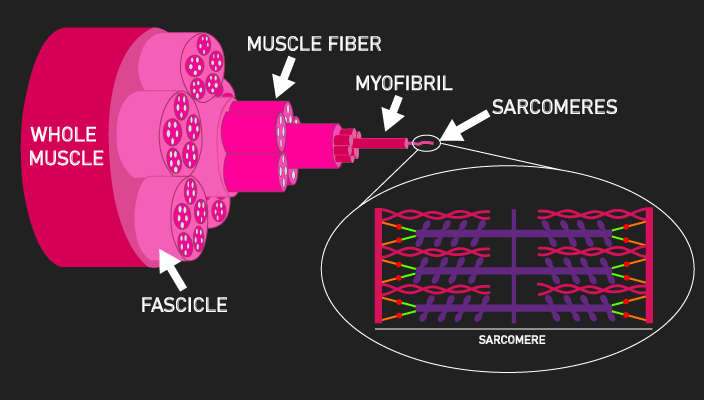
Myofibrils are where the magic of muscle contraction happens, they consist of an array of sarcomeres.
Sarcomeres are what generate muscle force.
Specifically, when something called the myosin head extends from the myosin filament and pulls on something called the actin filament towards the M-line, force is generated.

B) The myosin heads extend from the myosin filaments and attach to the actin filaments.
C) The myosin filaments pull the actin filaments towards to M-line, shortening the sarcomere length.
Defining Myofibrillar Hypertrophy, Sarcoplasmic Hypertrophy, and Myofibrillar Packing
To define each of the 3 underlying ways a muscle fiber can increase in cross-sectional area, we need to return to the muscle fiber level.
As we’ve mentioned, muscle fibers contain myofibrils, which are what generate force via their sarcomeres.
Everything else within the muscle fiber can be considered the sarcoplasm.
The sarcoplasm largely consists of water but also contains other components, such as glycogen, sarcoplasmic proteins, and non-contractile organelles (like mitochondria, the sarcoplasmic reticulum, and transverse tubules).
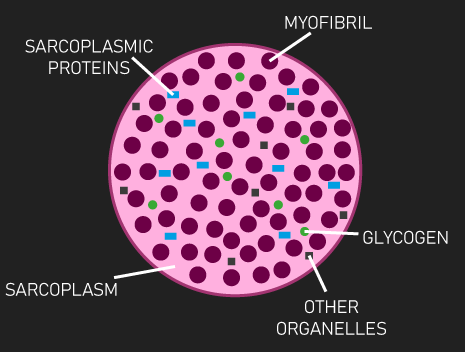
Myofibrillar hypertrophy is where the myofibrils and sarcoplasm grow at the same pace, meaning the relative space taken up by the myofibrils and sarcoplasm remains the same.

Sarcoplasmic hypertrophy is where the sarcoplasm grows at a greater pace than the myofibrils, meaning the relative space taken up by the sarcoplasm becomes greater.

It’s important to emphasize the myofibrils have not decreased in size or number.
Rather, the myofibrils could have very well grown, but it’s just the sarcoplasm grew at a faster pace.
Or alternatively, the myofibrils may have not grown at all, while the sarcoplasm only grew.
Myofibrillar packing is where the myofibrils grow at a greater pace than the sarcoplasm, meaning the relative space taken up by the myofibrils becomes greater.

Again, it’s important to emphasize the sarcoplasm has not decreased in size.
Now, one noteworthy point with myofibrillar packing is that it’s plausible myofibrils grow yet do not increase the cross-sectional area of a muscle fiber (this is shown in the image above).
Nonetheless, there are two ways I’m aware of where myofibrillar packing can still increase muscle fiber cross-sectional area.
Firstly, it’s possible myofibrils can grow to the point where they push the outer wall of a muscle fiber, thereby creating an increase in cross-sectional area.
Or secondly, along with myofibril growth, the sarcoplasm does grow to a degree, collectively creating an increase in muscle fiber cross-sectional area. It’s important to emphasize in this scenario, although the sarcoplasm grows, myofibril growth would outpace the sarcoplasm growth, as this is following the myofibrillar packing definition.
How Researchers Assess Changes at the Fiber Level
By my count, there seem to be three methods in which researchers can assess whether myofibrillar hypertrophy, sarcoplasmic hypertrophy, myofibrillar packing occurs.
Either by running a long-term study with direct assessments, a long-term study measuring specific tension, or a cross-sectional study.
Firstly, we’ll assess how each of these three methods works.
Then, we’ll directly look at the actual studies conducted in hope of answering the article’s primary questions.
Long-Term Study With Direct Assessments
Long-term studies that use direct assessments have subjects train for some duration.
Before and after this training duration, researchers extract a sample of muscle from subjects and measure the cross-sectional area of the muscle fibers.
Additionally, researchers will calculate or estimate the relative space taken up by myofibrils and/or sarcoplasm within the samples obtained using various methodologies and equipment.
Therefore, in essence, this method enables researchers to directly assess if myofibrillar hypertrophy, sarcoplasmic hypertrophy, or myofibrillar packing has occurred.
Limitation
Now, there is a noteworthy limitation with the whole method of using a long-term study design with direct assessments
It’s impossible to assess the exact same set of muscle fibers from subjects before and after the study.
This is because, before the training duration, the muscle fibers are extracted and taken out of the subject, meaning that they are no longer part of the subject’s muscle.
After the training duration, another muscle sample is taken from the same region of a muscle.
This may seem like a serious limitation. However, the reason this method is considered valid is that it’s assumed muscle fibers in a particular region of a muscle share similar characteristics.
Hence, any alterations in the muscle fibers sampled after the study should be representative of any alterations that would have occurred in the muscle fibers that were sampled before the training duration.
Long-Term Studies Measuring Specific Tension
Moving on, the second way researchers can assess changes at the muscle fiber level is through long-term term studies measuring specific tension.
Like the previous method, subjects train for some duration.
Before and after this training duration, researchers extract a sample of muscle from subjects and measure the cross-sectional area of the muscle fibers, as well as the specific tension of the muscle fibers.
The obvious question here is: what is specific tension?
Researchers calculate it by simply diving the amount of force a muscle fiber can produce by its cross-sectional area.
Therefore, specific tension is the amount of force a muscle fiber can produce per unit of cross-sectional area.
In a muscle fiber, recall the myofibrils are what generate force via their sarcomeres.
On the other hand, the sarcoplasm does not generate any force.
So, as specific tension is the amount of force a muscle fiber can produce per unit of cross-sectional area, and as myofibrils are what generate force, specific tension ultimately reflects the relative space taken up by myofibrils.
Therefore, it follows that an increase in specific tension suggests the muscle fibers have more relative space taken up by the myofibrils. As we know, this is myofibrillar packing.
Opposingly, a decrease in specific tension suggests the muscle fibers now have less relative space taken up by the myofibrils. Indirectly, this also indicates the sarcoplasm would now occupy more relative space. As we know, this is sarcoplasmic hypertrophy.
Finally, if specific tension remains unchanged to the values from before the training duration, this suggests the relative space taken up by the myofibrils remains the same. As we know, this is myofibrillar hypertrophy.
Limitation
Now, long-term studies measuring specific tension, like the last method, require taking a sample of muscle before and after the study from subjects. As a result, the same limitation is present. Namely, It’s impossible to assess the exact same set of muscle fibers from subjects before and after the study.
Cross-Sectional Studies
The final method I’m aware of that researchers can use to assess changes at the muscle fiber level are cross-sectional studies.
This is where researchers recruit different groups of subjects and compare characteristics between them.
For example, researchers may recruit untrained individuals and bodybuilders.
Then, the researchers may compare not only the cross-sectional area of muscle fibers between the untrained subjects and bodybuilders but also the relative space taken up by myofibrils within the bodybuilder’s muscle samples to the relative space taken up by myofibrils within the untrained individual’s muscle sample, via direct assessments.
Of course, the bodybuilders would typically have larger muscle fibers.
But, in a possible scenario, the bodybuilder’s myofibrils make take up less relative space in their samples compared to untrained individuals.
From this, we could suggest that perhaps bodybuilding training produces muscle fiber growth via sarcoplasmic hypertrophy, as the lower relative space taken up by myofibrils in the bodybuilders (compared to the untrained subjects) may be indicative of greater growth of the sarcoplasm versus the myofibrils.
Aside from cross-sectional studies using direct assessments, researchers could instead (or additionally) compare the specific tension values of muscle fibers between the two groups of subjects.
In a similar scenario, if the muscle fibers of bodybuilders had a lower specific tension compared to untrained individuals, we may also suggest bodybuilding training produces muscle fiber growth by sarcoplasmic hypertrophy, as lower specific tension (which we know reflects the relative space taken up by the myofibrils) would potentially imply the bodybuilders experienced greater growth of the sarcoplasm versus the myofibrils.
Limitation
Now, one of the limitations of cross-sectional studies is that any differences observed between two groups (like untrained subjects and bodybuilders) may not necessarily be a result of the training differences between them.
For instance, in the hypothetical examples given, the bodybuilders had lower relative space taken up myofibrils or lower specific tension compared to the untrained individuals.
However, these differences may not be related to training, rather it’s quite possible the bodybuilders had a lower relative space taken up myofibrils or lower specific tension before they even began training.
The Research: Myofibrillar Hypertrophy vs Sarcoplasmic Hypertrophy vs Myofibrillar Packing
Okay, now we understand the 3 ways researchers could go about determining how training changes the muscle fiber level, let us actually evaluate the current evidence.
In total, I’m aware of 15 long-term studies using direct assessments, 12 long-term studies measuring specific tension, and 6 cross-sectional studies.
For myofibrillar hypertrophy, 5 long-term studies using direct assessments (one, two, three, four, five) , 8 long-term studies measuring specific tension (one, two, three, four, five, six, seven, eight) , and 2 cross-sectional studies find evidence for it (one and two) (so a total of 15 studies).
For sarcoplasmic hypertrophy, 5 long-term studies using direct assessments (one, two, three, four, five) , 0 long-term studies measuring specific tension, and 2 cross-sectional studies find evidence for it (one and two) (so a total of 7 studies).
For myofibrillar packing, 5 long-term studies using direct assessments (one, two, three, four, five) , 4 long-term studies measuring specific tension (one, two, three, four) , and 2 cross-sectional studies find evidence for it (one and two) (so a total of 11 studies).
Therefore, when evaluating the overall evidence, myofibrillar hypertrophy is just about the most observable way in which muscle fibers grow in the current research.
However, let us now briefly overview the training variables used in these various studies to determine if you can specifically train for myofibrillar hypertrophy, sarcoplasmic hypertrophy, or myofibrillar packing.
Can You Train For Myofibrillar Hypertrophy, Sarcoplasmic Hypertrophy, or Myofibrillar Packing?
Myofibrillar Hypertrophy Research
Here is a table listing the long-term studies using direct assessments that find evidence for myofibrillar hypertrophy.

We’ll be using a color code to determine what load, frequency, and volume the studies used. The key can be seen below.

As we can see, the majority of these long-term studies using direct assessments finding myofibrillar hypertrophy used moderate loads, low-moderate training frequencies, as well as low-moderate volumes.
For the long-term studies using specific tension that found evidence for myofibrillar hypertrophy, the story is the same. That is, the majority of studies used moderate loads, low-moderate training frequencies, and low-moderate volumes.
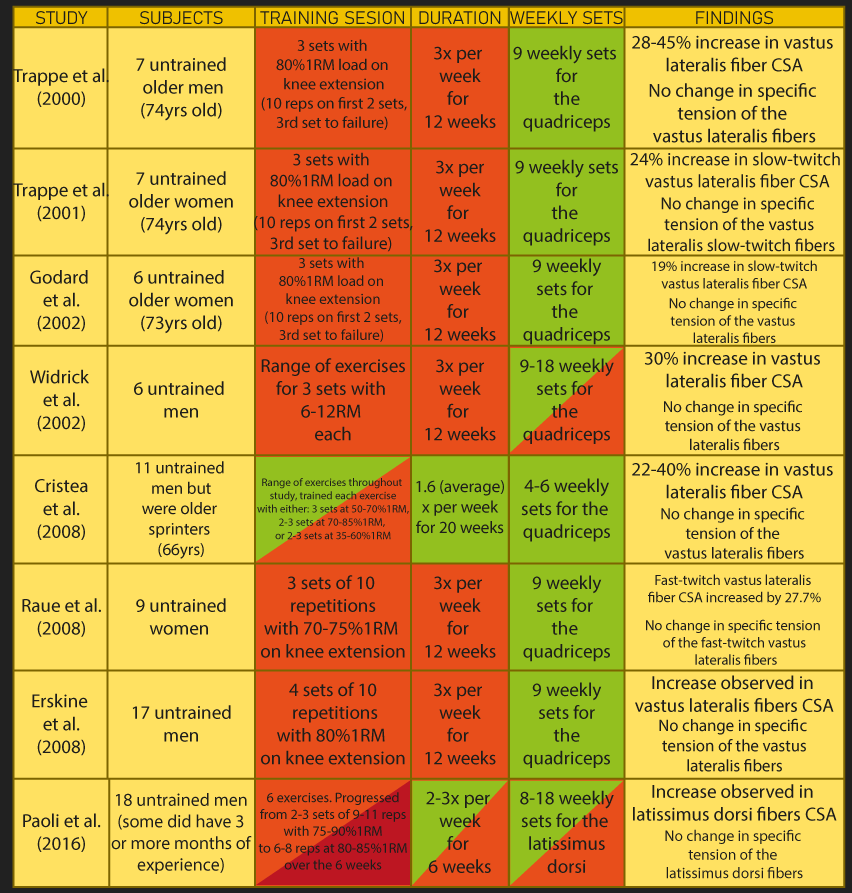
As for the cross-sectional studies, they indicate bodybuilders, powerlifters, and recreationally trained men potentially experienced myofibrillar hypertrophy.
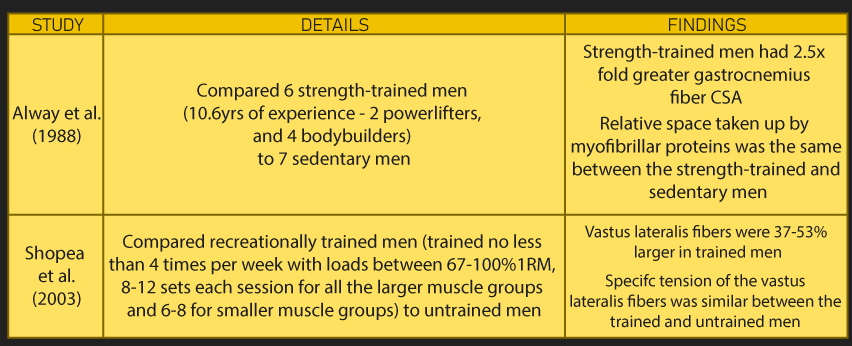
Now, it’s a little more difficult to draw any conclusions from this. Firstly, there are only two studies. Secondly, as we know, cross-sectional studies don’t include a training duration, they merely compare characteristics between two different groups.
That said, the study by Shopea et al. did provide some broad training details, which suggest the group of recreationally trained men who potentially experienced myofibrillar hypertrophy were using moderate-heavy loads and moderate training frequencies. As for volume, given no details on how many exercises they generally perform for each muscle group, we don’t know.
Nevertheless, to sum up, the research finding myofibrillar hypertrophy largely used moderate loads, low-moderate training frequencies, and low-moderate volumes.
Before moving on, if you’re curious about creating an effective training program for muscle hypertrophy, our high quality partner Alpha Progression can help. It can generate a highly effective program for you, track your workouts live with in-built progression recommendations, provide graphs displaying your long term progress, and it has a massive exercise database with more than 550 exercises.
Click HERE (the link opens in a new tab) to get a free 2 week trial of the apps features. If you like it and go beyond, the link also gives you 20% off a subscription!
We never promote trash at the House of Hypertrophy, so rest assured the app is high quality. The reviews speak to this, 4.8 starts (based on more than 7,000 reviews) on Google play, and 4.9 stars in Apple’s store (based on nearly 400 ratings).
Sarcoplasmic Hypertrophy Research
Moving on to sarcoplasmic hypertrophy, the majority of the supporting long-term studies using direct assessments used moderate loads, moderate frequencies, and high volumes.

The high volume seems to be noteworthy, as this is the only training variable that differs from the studies that found myofibrillar hypertrophy.
Thus, perhaps using higher volumes make it more likely you experience sarcoplasmic hypertrophy.
However, caution is advised, as only the slightly majority (3/5) of the studies used high volumes.
However, I should note that one of the studies by Penman, in which low volumes were used, should probably be viewed with caution. They only had three subjects and thus no statistical analyses were performed. Additionally, no fiber or whole muscle growth measurement was given.
With this in mind, perhaps the argument that sarcoplasmic hypertrophy is made more likely with higher volumes is strengthened.
As for long-term studies measuring specific tension that found sarcoplasmic hypertrophy, there are none, so there’s nothing to analyze here.
For supporting cross-sectional studies, there are two studies finding that bodybuilders and powerlifters potentially experienced sarcoplasmic hypertrophy.

Again, it’s a little difficult to draw any firm conclusions from this limited number of cross-sectional studies.
But, the study by Meijer et al. found in bodybuilders that potentially experienced sarcoplasmic hypertrophy, they were performing 4-5 sets with each exercise. Assuming they performed multiple exercises per muscle group, this likely indicates they were close to or using high volumes.
Therefore, this cross-sectional study may further support the notion that high volume may make sarcoplasmic hypertrophy more likely. However, this is tentative, as this is only one cross-sectional study, and we still cannot be certain on the exact weekly sets the bodybuilders performed.
Nonetheless, to sum up, the research finding sarcoplasmic hypertrophy largely used moderate loads, moderate training frequencies, and high volumes.
Myofibrillar Packing Research
Moving forward to myofibrillar packing, the supporting long-term studies using direct assessments mainly used moderate loads, moderate frequencies, and low-moderate volumes.
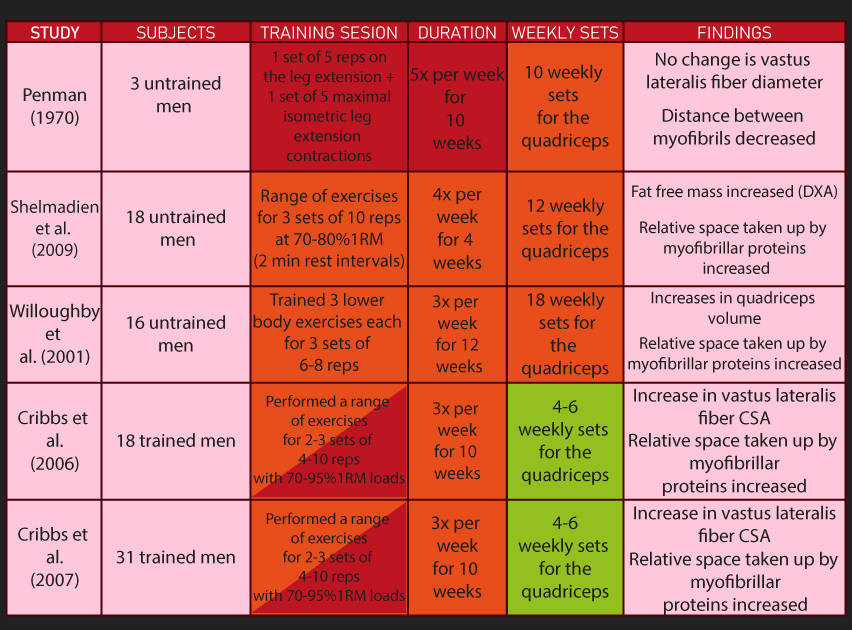
For the majority of long-term studies measuring specific tension, the same training variables were used: moderate loads, moderate frequencies, and low-moderate volumes.

As for the cross-sectional evidence, two studies found that bodybuilders and recreationally trained men potentially experienced myofibrillar packing.
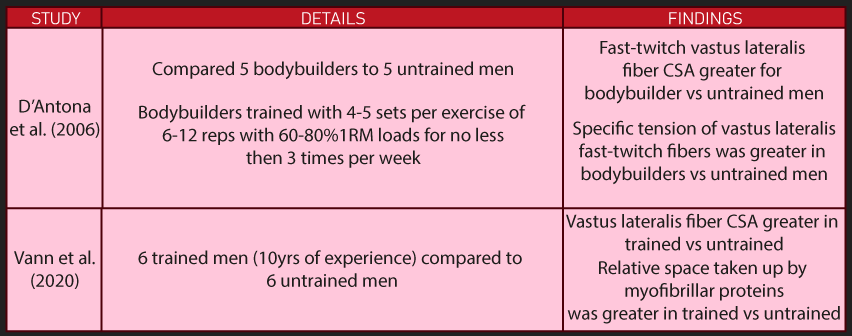
Interestingly, one of these studies by D’Antona et al. reported the bodybuilders were training with 4 to 5 sets per exercise. Assuming these bodybuilders performed multiple exercises per muscle group, this suggests they were perhaps using high volumes.
As a result, this study may go against the notion the sarcoplasmic hypertrophy is made more likely by higher volumes.
But, as we know, it’s a little difficult to draw firm conclusions from cross-sectional studies.
Nevertheless, in summary, the majority of the research finding evidence for myofibrillar packing used moderate loads, moderate frequencies, and low-moderate volumes.
Evaluating the Overall Evidence
Combining our summaries of all of the current research, it appears volume may be the differentiating factor on whether you experience myofibrillar hypertrophy, sarcoplasmic hypertrophy, or myofibrillar packing.
More precisely, training with low to moderate volumes appears to be associated with myofibrillar hypertrophy or myofibrillar packing.
Now, given the studies that found myofibrillar hypertrophy or myofibrillar packing used nearly identical training variables, it’s currently not clear whether you can specifically train for either. Perhaps it isn’t possible, or perhaps there are more complex underlying factors that just aren’t currently evident.
On the other hand, training with higher volumes appears to be associated with sarcoplasmic hypertrophy.
It’s important to emphasize that by no means are these conclusions definitive.
Particularly, as we know, the interpretation sarcoplasmic hypertrophy is achieved with higher volumes is only derived from a few studies.
Future research will still be valuable for providing more clarity on whether high volumes truly elicit sarcoplasmic hypertrophy.
Another thing that may be useful in future research is the exploration of training with heavy or light loads exclusively.
As was evident when exploring the research, nearly every study used moderate loads.
Therefore, we currently don’t have any direct research exploring whether training with light or heavy loads only could preferentially elicit myofibrillar hypertrophy, sarcoplasmic hypertrophy, or myofibrillar packing.
Takeaway Points
- We have a fair degree of evidence supporting the existence of myofibrillar hypertrophy, sarcoplasmic hypertrophy, and myofibrillar packing.
- At this time, it’s not clear whether you can specifically train for either myofibrillar hypertrophy or myofibrillar packing, but both of these seem to be achieved when training with low to moderate volumes.
- Conversely, training with higher volumes may make sarcoplasmic hypertrophy more likely.
- With regards to whether the type of loading you use has an impact, the current evidence is not sufficient to tell us. Nearly every study in this area used moderate loads, and this loading produced all the 3 types of muscle fiber growth.
- Future research that uses either heavy or light loads exclusively should provide clarity on whether these loads can preferentially produce myofibrillar hypertrophy, sarcoplasmic hypertrophy, or myofibrillar packing.
Remember to feel free to check out the Alpha Progression App if you’re interested. Also feel free to check out our free bench press e-book below.

